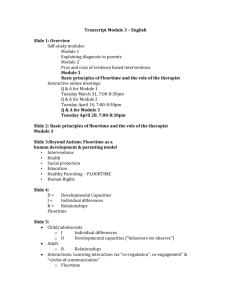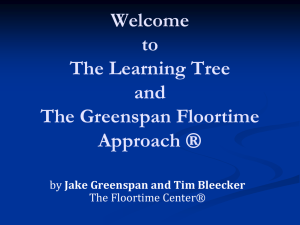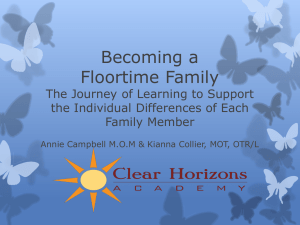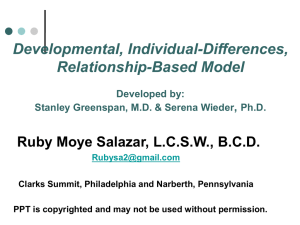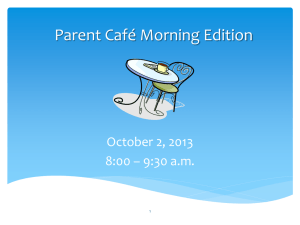floor time
advertisement
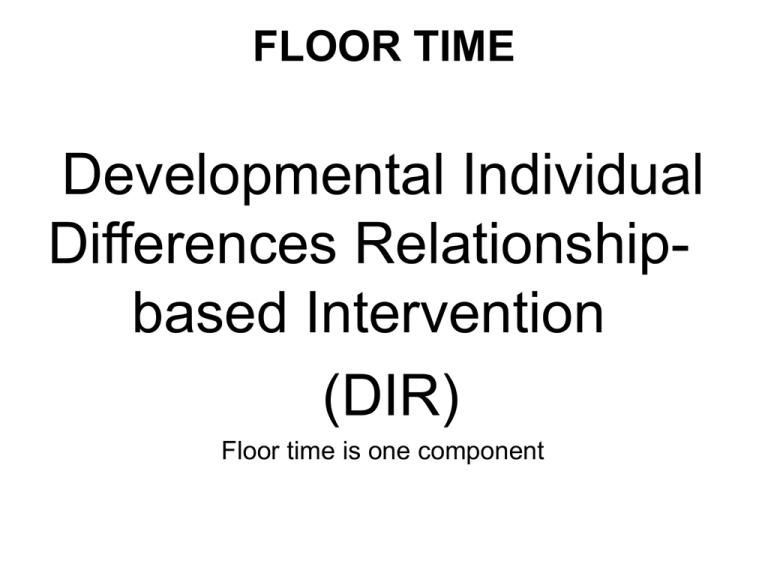
FLOOR TIME Developmental Individual Differences Relationshipbased Intervention (DIR) Floor time is one component Developed by psychiatrist Stanley Greenspan and psychologist Serena Weider. Help the child build the healthy foundations for relating, communicating and thinking. Mastering these healthy developmental foundations also helps children overcome their symptoms, usually more effectively than attempts to change symptoms alone. The Floortime component of DIR - working with children at their current developmental level inducing them to interact and engage with others. This often requires the parent or professional to get down on the floor with a child - “Floortime.” Practitioners follow the child’s lead, using intrinsic motivation to help the child move up the developmental ladder. The claim is that intensive DIR therapy can lead to children with ASD becoming warmer, more engaging, and more communicative. One of the advantages to their approach, they feel, is that children can learn to be more flexible and spontaneous The D (Developmental) part of the Model describes the building blocks of this foundation. Understanding where the child is developmentally is critical to planning a treatment program. I (Individual differences) describes the unique biologically-based ways each child takes in, regulates, responds to, and comprehends sensations such as sound, touch, and - planning / sequencing of actions / ideas. Biological Challenges describes the various processing issues that make up a child's individual differences and that may be interfering with his ability to grow and learn. R (Relationship-based) describes the learning relationships with caregivers, educators, therapists, peers, and others who tailor their affect based interactions to the child’s individual differences and developmental capacities to enable progress in mastering the essential foundations. Floortime is a specific technique to both follow the child’s natural emotional interests (lead) and at the same time challenge the child towards greater and greater mastery of the social, emotional and intellectual capacities. With young children these playful interactions may occur on the “floor”, but go on to include conversations and interactions in other places. • 1. Floortime™, spontaneous interactions during which the caregiver follows the child's lead and helps her elaborate • Follow the child's lead • Join in at the child's developmental level and build on her natural interests. • Open and close circles of communications • Create a play environment with rattles, balls, dolls, action figures, cars, trucks, schools, etc. that will provide a vehicle for the child's natural interests and facilitate opening and closing circles of communication. • Broaden the child's range of interactive experience • Broaden the range of processing and motor capacities used in interactions • Tailor your interactions to the child's individual differences in auditory processing, visual-spatial processing, motor planning and sequencing, and sensory modulation. Simultaneously attempt to mobilize the six functional developmental levels attention, engagement, gestures, complex preverbal problem-solving, using ideas, and connecting ideas for thinking Younger children or children with developmental challenges will master the later levels as they develop 2. Semistructured, problemsolving interactions, specific learning objectives are worked on through the creation of dynamic challenges that the child wants to solve. 3. Motor, sensory, perceptualmotor, and visual-spatial physical activities to strengthen important processing foundations. Greenspan’s Functional Emotional Development Scale: • Self-regulation and interest in the world (3 mos.) • Forming relationships, attachment and engagement (8 mos.) • Intentional two-way communication (9 mos.) • Complex sense of self (12-36 mos.) • Emotional ideas ( 24-36 mos.) • Emotional thinking ( 36-48 mos.) Self-regulation and interest in the world: Emerging interest in the world through the senses Critical in successful adaptation to the environment Result of physical maturation, caregiver responsivity and the infants adaptations to environmental demands Co-regulation - This is the basis for affect atonement If this doesn’t develop, withdrawal from arousing stimuli may occur Emotional Ideas: ! The creation, elaboration and sharing of symbols and meanings ! The individual’s ability to represent or symbolize experience is illustrated in the pretend play, the verbal labelling of feelings and the functional use of language ! Internal sensations and unstable images become organized as multi-sensory, affective images ! The development of both object permanence and perspective-taking Emotional Thinking: ! Building logical bridges between ideas ! Shared meanings are used to elaborate wishes and feelings and to categorize meanings and solve problems ! The child begins to differentiate actions of others from his own and between what is real and what unreal and what is right and wrong ! As well, impulse and mood regulation, dealing with conflict and finding prosocial outcomes What is Floortime? ! 20-30 minutes of uninterrupted play time ! Greenspan suggests 5 sessions per day ! Provide a play space that allows for some movement and exploration. Goals of Floortime ! Engagement ! Two-way communication ! Shared meaning ! Emotional thinking Strengthen Development: ! Motor ! Sensory ! Language ! Cognitive Desired Goal Behaviors: ! Be alert and aware ! Take initiative ! Be flexible ! Longer sequencing of actions ! Problem solving ! Tolerate frustration ! Take pleasure in learning ! Communicate gesturally and verbally ! Plan and execute Steps in Floor Time: • • • • • ! Observe ! Open circle ! Follow child’s lead (or his intent) ! Extend and expand play ! Child closes circle Floor timers use: ! Slow approaches ! Calm voices ! Speaking slowly ! Gentle looks ! Supportive gestures ! Non-intrusive ! Supportive listening Floor time behavior ! Mimic child’s rhythms ! Get into child’s themes ! Observe child ! Respect child ! Empathy for child’s feelings ! Understand child’s needs Ask open-ended questions: ! Who? ! What ? ! Where? ! When? ! Why? ! How? Use Everyday Activities: ! Dressing ! Meal times ! Car times ! Transition ! Bath time ! Reading time ! Bed time Props Needed: ! Toy food ! Transportation ! Empathy and Nurturing of others ! Fantasy play ! Communications ! Reading ! Aggression fantasy ! Construction play ! Art play ! Outdoor play ! Constructive obstruction props Problem solve changes in: ! Routines ! Expectations ! Personal wishes ! Daily challenges Encourage emotional themes of: ! Closeness ! Pleasure ! Excitement ! Assertive curiosity ! Anger ! Limit setting ! Distress ! Recovery
